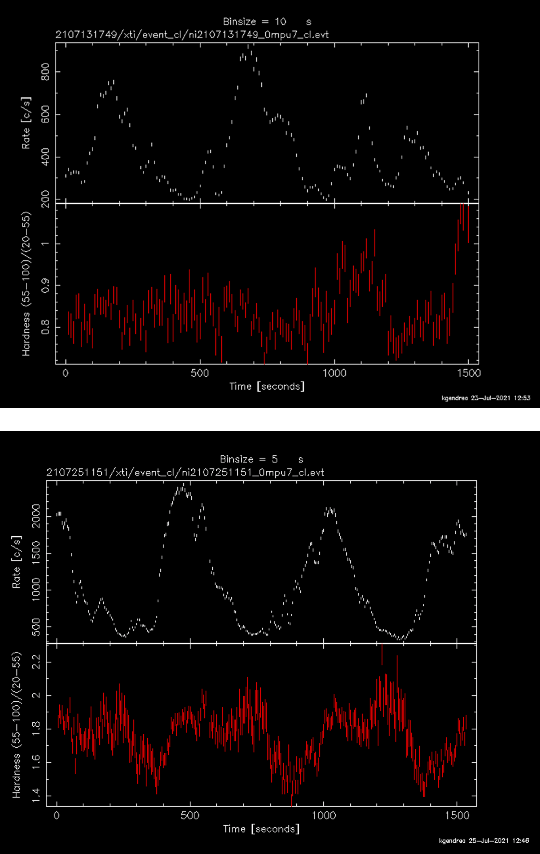NICER / ISS Science Nugget
for August 5, 2021
The Changing X-ray Colors of a Spinning White Dwarf
A "classical nova" in the constellation Hercules was discovered on 12 June, 2021, in visible-light observations by Japanese astronomer Seiji Ueda. It quickly brightened to the point that it could be seen with binoculars, and a worldwide effort to observe this so-called cataclysmic variable established that it shines in all electromagnetic wavebands, from radio through gamma-rays. These emissions originate in a binary system consisting of a white-dwarf star accreting material from a hydrogen-rich companion star, with the collected matter on the surface of the white dwarf ultimately igniting in a nuclear fusion-powered explosion that expels a luminous cloud of debris into the interstellar medium, with different aspects of this process responsible for the emissions at different wavelengths. Notably, optical observations discovered an 8.3-min periodicity, attributed to the spin of the white dwarf -- its strong magnetic field channels the flow of accreted matter onto the star's magnetic poles, which are swept into and out of view as the star spins.
NICER responded to two target-of-opportunity requests for observations in early July, following detections of Nova Herculis 2021 in X-rays with NASA's Swift and Chandra telescopes. The X-ray emission exhibits the same 8.3-min period as in visible light, and represents the "hot spots" on the star's surface where the magnetic poles are heated by the accreted matter; the results of early NICER observations were reported in Astronomer's Telegram #14798.
NICER continued to monitor the brightening of the nova in X-rays, which in the last week has peaked and begun to slowly fade. Comparison of the pulsation profile -- how the apparent X-ray brightness varies with the white dwarf's spin -- shows a marked evolution over the course of the outburst. Because the source is so bright, providing more than 2000 photons per second near peak brightness, NICER's observations provide an unprecedented view of the X-ray spectrum as it changes with the star's spin. A single number that is frequently used as a top-level summary of spectral properties is known as the "hardness ratio", simply the ratio of brightness in high-energy (hard) vs. low-energy (soft) X-rays. Variations in hardness ratio with rotation phase, and also over the span of the outburst, will provide unique insights into the accretion geometry, the chemical makeup of the white dwarf's atmosphere, and the energetics of how it is heated.

Figure: NICER pulse profiles of Nova Herculis 2021, obtained on 13 July (top) and 25 July (bottom). In each image, the upper panel shows the total brightness (rate of X-ray photon detections per second), while the lower panel shows the ratio of counts in a higher photon-energy band (0.55-1 keV) to a lower-energy (0.2-0.55 keV) band, a measure of X-ray "color". The spectrum varies with pulse phase, and both the spectrum and overall pulse shape are seen to evolve with time.
<< Previous
Main Index